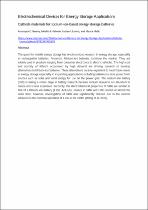JavaScript is disabled for your browser. Some features of this site may not work without it.
- ResearchSpace
- →
- Research Publications/Outputs
- →
- Book Chapters
- →
- View Item
| dc.contributor.author |
Nwany, AC

|
|
| dc.contributor.author |
Kebede, Mesfin A

|
|
| dc.contributor.author |
Ezema, FI

|
|
| dc.date.accessioned | 2020-04-13T07:42:23Z | |
| dc.date.available | 2020-04-13T07:42:23Z | |
| dc.date.issued | 2019-12 | |
| dc.identifier.citation | Nwany, A.C., Kebede, M.A., Ezema, F.I. & Malik, M. Cathode materials for sodium-ion-based energy storage batteries. In: Kebede, MA and Ezema, F.I. (eds). 2019. Electrochemical Devices for Energy Storage Applications, United Kingdom: Taylor & Francis Group, CRC Press, pp 59-80 | en_US |
| dc.identifier.isbn | 9780367425678 | |
| dc.identifier.uri | https://www.crcpress.com/Electrochemical-Devices-for-Energy-Storage-Applications/Kebede-Ezema/p/book/9780367425678 | |
| dc.identifier.uri | http://hdl.handle.net/10204/11420 | |
| dc.description | Copyright: 2019, Taylor & Francis Group, CRC Press. Due to copyright restrictions, the attached PDF file contains the abstract of the full-text item. For access to the full-text item, please consult the publisher's website: https://www.taylorfrancis.com/books/e/9780367855116 | en_US |
| dc.description.abstract | The quest for mobile energy storage has revolutionized research in energy storage, especially in rechargeable batteries. Presently, lithium-ion batteries dominate the market. They are widely used in products ranging from consumer electronics to electric vehicles. The high cost and scarcity of lithium occasioned by high demand are driving research to develop alternatives to lithium-ion batteries. These alternatives became expedient to meet future needs in energy storage especially in expanding applications including batteries to store power from sources such as solar and wind energy for use on the power grid. The sodium-ion battery (SIB) is taking a centre stage in battery research because sodium resources are abundant in nature and is less expensive. Secondly, the electrochemical properties of SIBs are similar to that of a lithium-ion battery (LIB). Actually, studies in SIBs and LIBs started at almost the same time; however, investigation of SIBs was significantly reduced due to the success achieved in the commercialization of LIBs in the 1990s (Wang et al. 2018). | en_US |
| dc.language.iso | en | en_US |
| dc.publisher | Taylor & Francis Group, CRC Press | en_US |
| dc.relation.ispartofseries | Workflow;23108 | |
| dc.subject | Cathode materials | en_US |
| dc.subject | Mobile energy storage | en_US |
| dc.title | Cathode materials for sodium-ion-based energy storage batteries | en_US |
| dc.type | Book Chapter | en_US |
| dc.identifier.apacitation | Nwany, A., Kebede, M. A., & Ezema, F. (2019). Cathode materials for sodium-Ion-Based energy storage batteries., <i>Workflow;23108</i> Taylor & Francis Group, CRC Press. http://hdl.handle.net/10204/11420 | en_ZA |
| dc.identifier.chicagocitation | Nwany, AC, Mesfin A Kebede, and FI Ezema. "Cathode materials for sodium-ion-based energy storage batteries" In <i>WORKFLOW;23108</i>, n.p.: Taylor & Francis Group, CRC Press. 2019. http://hdl.handle.net/10204/11420. | en_ZA |
| dc.identifier.vancouvercitation | Nwany A, Kebede MA, Ezema F. Cathode materials for sodium-ion-based energy storage batteries.. Workflow;23108. [place unknown]: Taylor & Francis Group, CRC Press; 2019. [cited yyyy month dd]. http://hdl.handle.net/10204/11420. | en_ZA |
| dc.identifier.ris | TY - Book Chapter AU - Nwany, AC AU - Kebede, Mesfin A AU - Ezema, FI AB - The quest for mobile energy storage has revolutionized research in energy storage, especially in rechargeable batteries. Presently, lithium-ion batteries dominate the market. They are widely used in products ranging from consumer electronics to electric vehicles. The high cost and scarcity of lithium occasioned by high demand are driving research to develop alternatives to lithium-ion batteries. These alternatives became expedient to meet future needs in energy storage especially in expanding applications including batteries to store power from sources such as solar and wind energy for use on the power grid. The sodium-ion battery (SIB) is taking a centre stage in battery research because sodium resources are abundant in nature and is less expensive. Secondly, the electrochemical properties of SIBs are similar to that of a lithium-ion battery (LIB). Actually, studies in SIBs and LIBs started at almost the same time; however, investigation of SIBs was significantly reduced due to the success achieved in the commercialization of LIBs in the 1990s (Wang et al. 2018). DA - 2019-12 DB - ResearchSpace DP - CSIR KW - Cathode materials KW - Mobile energy storage LK - https://researchspace.csir.co.za PY - 2019 SM - 9780367425678 T1 - Cathode materials for sodium-ion-based energy storage batteries TI - Cathode materials for sodium-ion-based energy storage batteries UR - http://hdl.handle.net/10204/11420 ER - | en_ZA |






